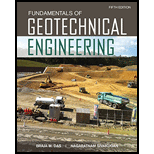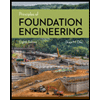
(a)
Find the settlement in sands in 10 years using the strain influence factor method.
(a)
Answer to Problem 17.17CTP
The settlement in sands in 10 years using the strain influence factor method is
Explanation of Solution
Given information:
The width (B) of the continuous foundation is 2.0 m.
The cone penetration resistance
The cone penetration resistance
The depth of footing
The thickness
The unit weight
The saturated unit weight
The stress
The elasticity of sand layer is
Calculation:
Find the applied stress (q) using the equation:
Substitute
Find the effective stress at the depth of
Substitute
Find the maximum value of strain influence factor
Substitute
Find the correction factor
Substitute
Find the correction factor
Substitute 10 years for t.
Find the elasticity of the sand layer
Substitute
Find the elasticity of the sand layer
Substitute
For continuous foundation
Sketch the strain influence diagram as shown in Figure 1.

Refer Figure 1.
Find the strain influence factor
Find the term
Find the term
Find the term
Substitute 0.84 m for
Find the settlement in sand
Substitute 0.92 for
Therefore, the settlement in sands in 10 years using the strain influence factor method is
(b)
Find the elastic settlement in the clay assuming undrained conditions.
(b)
Answer to Problem 17.17CTP
The elastic settlement in the clay assuming undrained conditions is
Explanation of Solution
Given information:
The elasticity of soil is
Calculation:
Consider two homogenous clay layers below the base of the foundation. One is the clay layer up to 4 m depth below foundation and another one is clay layer up to 2 m below foundation.
Sketch the cross section of clay layer 1 as shown in Figure 2.

Here, the depth of clay layer (H) is 4 m.
Find the ratio of depth of footing to breadth of footing
Substitute 1 m for
Find the ratio of length of footing to breadth of footing
Substitute
Find the ratio of depth of clay layer to breadth of footing
Substitute 4 m for H and 2 m for B.
Find the net applied pressure
Substitute
Find the factor
Refer Table 17.1, “Variation of
Take the value of
Determine the factor
Refer Table 17.2, “Variation of
Take the value of
Find the elastic settlement of clay layer 1
Substitute 0.975 for
Sketch the cross section of clay layer 2 as shown in Figure 3.

Here, the depth of clay layer (H) is 2 m.
Find the ratio of depth of footing to breadth of footing
Substitute 1 m for
Find the ratio of length of footing to breadth of footing
Substitute
Find the ratio of depth of clay layer to breadth of footing
Substitute 2 m for H and 2 m for B.
Find the net applied pressure
Substitute
Find the factor
Refer Table 17.1, “Variation of
Take the value of
Determine the factor
Refer Table 17.2, “Variation of
Take the value of
Find the elastic settlement of clay layer 2
Substitute 0.975 for
Find the elastic settlement of the clay layer
Substitute 6.7 mm for
Therefore, the elastic settlement in the clay assuming undrained conditions is
(c)
Find the consolidation settlement in the clay.
(c)
Answer to Problem 17.17CTP
The consolidation settlement in the clay is
Explanation of Solution
Calculation:
Find the increase in vertical stress at the top
Here, t is the thickness of the clay layer and
Substitute
Find the increase in vertical stress at the middle
Here,
Substitute
Find the increase in vertical stress at the bottom
Here,
Substitute
Find the average increase in vertical stress
Substitute
Find the initial effective over burden stress at the middle of the clay layer
Substitute 3 m for D,
Find the consolidation settlement in the clay
Substitute 0.4 for
Therefore, the consolidation settlement in the clay is
(d)
Find the settlement of the footing in 10 years.
(d)
Answer to Problem 17.17CTP
The settlement of the footing in 10 years is
Explanation of Solution
Calculation:
Find the settlement (total settlement) of the footing in 10 years
Substitute 7.55 mm for
Therefore, the settlement of the footing in 10 years is
Want to see more full solutions like this?
Chapter 17 Solutions
Fundamentals of Geotechnical Engineering (MindTap Course List)
- A 6 m. x 9 m. rectangular foundation carrying a uniform load of 288 kPa is applied to the ground surface. Compute the total vertical stress in kPa due to this uniform load at a depth of 6 m. below the center of the loaded area if unit weight of soil is 18,30 kN/m.arrow_forwarda 6m square foundation exerts a uniform pressure of 300kPa on a soil.Determine a.vertical stress increments due to the foundation load to a depth of 10m below its centerarrow_forwardSolve Problem 7.8 using Eq. (7.29). Ignore the post-construction settlement. 7.8 Solve Problem 7.4 with Eq. (7.20). Ignore the correction factor for creep. For the unit weight of soil, use γ = 115 lb/ft3. 7.4 Figure 7.3 shows a foundation of 10 ft × 6.25 ft resting on a sand deposit. The net load per unit area at the level of the foundation, qo, is 3000 lb/ft2. For the sand, μs = 0.3, Es = 3200 lb/in.2, Df = 2.5 ft, and H = 32 ft. Assume that the foundation is rigid and determine the elastic settlement the foundation would undergo. Use Eqs. (7.4) and (7.12).arrow_forward
- A 300 mm 450 mm plate was used in carrying out a plate loading test in a sand, during which the plate settled 5 mm under the applied pressure of 250 kN/m2. a. What is the coefficient of subgrade reaction for a 300 mm wide square plate? b. What would be the coefficient of subgrade reaction of a 2 m 3 m foundation?arrow_forwardThe subgrade reaction of a sandy soil obtained from the plate load test (plate dimensions 1 m × 0.7 m) is 18 MN/m3. What will be the value of k on the same soil for a foundation measuring 5 m × 3.5 m?arrow_forwardConsider a continuous foundation of width B = 1.4 m on a sand deposit with c = 0, = 38, and = 17.5 kN/m3. The foundation is subjected to an eccentrically inclined load (see Figure 6.33). Given: load eccentricity e = 0.15 m, Df = 1 m, and load inclination = 18. Estimate the failure load Qu(ei) per unit length of the foundation a. for a partially compensated type of loading [Eq. (6.89)] b. for a reinforced type of loading [Eq. (6.90)]arrow_forward
 Fundamentals of Geotechnical Engineering (MindTap...Civil EngineeringISBN:9781305635180Author:Braja M. Das, Nagaratnam SivakuganPublisher:Cengage Learning
Fundamentals of Geotechnical Engineering (MindTap...Civil EngineeringISBN:9781305635180Author:Braja M. Das, Nagaratnam SivakuganPublisher:Cengage Learning Principles of Foundation Engineering (MindTap Cou...Civil EngineeringISBN:9781337705028Author:Braja M. Das, Nagaratnam SivakuganPublisher:Cengage Learning
Principles of Foundation Engineering (MindTap Cou...Civil EngineeringISBN:9781337705028Author:Braja M. Das, Nagaratnam SivakuganPublisher:Cengage Learning Principles of Foundation Engineering (MindTap Cou...Civil EngineeringISBN:9781305081550Author:Braja M. DasPublisher:Cengage Learning
Principles of Foundation Engineering (MindTap Cou...Civil EngineeringISBN:9781305081550Author:Braja M. DasPublisher:Cengage Learning Principles of Geotechnical Engineering (MindTap C...Civil EngineeringISBN:9781305970939Author:Braja M. Das, Khaled SobhanPublisher:Cengage Learning
Principles of Geotechnical Engineering (MindTap C...Civil EngineeringISBN:9781305970939Author:Braja M. Das, Khaled SobhanPublisher:Cengage Learning



